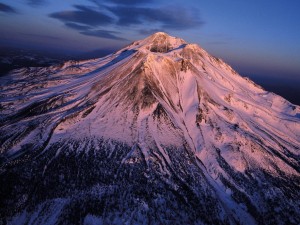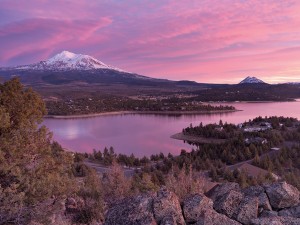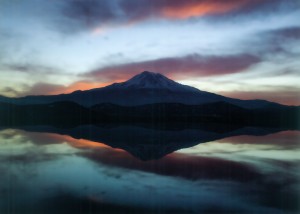SHASTA (USA)
3.2 Power place
Names
The origin of the name Shasta is still not fully understood today since local history and the inhabitants of the town, which bears the same name, provide five different explanations, as follows:
– Shasta was a famous Native American chief who appears in local history.
– Shasta was a local native tribe. Another variation claims that both the chief and the tribe adopted the name from another source.
– Shasta comes from the Native American word “Tsasdi” (spoken “shazdi”), meaning “three”, and refers to the “triple-towering mountain”.
– Shasta was named after the “Sasquatch” (“Bigfoot”), a name given by the indigenous people, a legendary being similar to the Yeti in the Himalayas, which is purported to live in the Shasta Mountains.
– The word “Shasta” is derived from the Russian language. Among the first immigrants was a Russian group that travelled south through California. They named many of the prominent landmarks, including Mount Shasta, which was permanently covered with snow, which they called „Cheste“ or „Chastal“, meaning virtuous, pure, or free. Subsequent travelers and geographers then changed the name to „Chasta“; its modern name „Shasta“ has been used since the discovery of gold in what is today Siskiyou County.
The most likely are variations one to three, which indicate the same roots. Four and five are more likely interpretations resulting from words whose pronunciation is similar.
Geomancy
The entire region is connected at this intersection of grid lines to a place of strong natural forces which manifest themselves in the surrounding environment, the mountains, lakes, and forests, as well as in the central volcanic formation. The following locations in particular are said to give the Shasta region its unique energy and keep this geomantic space in harmonious balance. First, there are three additional mountains:
– Castle Craigs, an imposing crystal-like rock formation in the Shasta-Trinity National Forest.
– Black Butte, a lava dome and satellite crater of Mount Shasta, located between Shasta and Weed.
– Glass Mountain, an obsidian mound near Medicine Lake, looks much like a gravel mound.
Springs, lakes, and waterfalls:
– Stewart Mineral Springs with their healing, mineral-rich waters that bubble up from under the rocks. There is an iron-rich red spring and a silica-rich white spring on Mount Shasta and, according to indigenous legends, they represent the masculine and feminine energies and the balance of polar forces.
– Shasta Springs which are often wide waterfalls, especially in the upper area near Dunsmuir (now privately owned by the St. Germain Foundation).
– At Lake Shasta itself, there are also large crystal-studded limestone caverns that can be accessed.
– Trinity Lake is nearby.
– Medicine Lake in Jasper National Park in the Maligne Valley, which is naturally dammed at the end and drains into one of the largest underground river systems on earth.
– Klamath Falls is located on Upper Klamath Lake, the largest natural lake in the Pacific Northwest.
– Mossbrae Falls, fed by Shasta Springs, flow into the Sacramento River in Dunsmuir.
– The Upper, Middle, and Lower McCloud Falls are found in the Shasta-Trinity National Forest.
Each of these places is truly remarkable, worth seeing and experiencing.
Power point
The main power point is the mountain itself and what lies beneath, and the location of the intersection of energy lines cannot be precisely described.
Some say it lies in the center of the old volcano crater, others at Mount Shastina, and still others at Medicine Lake at the foot of the mountain (similar to Kailash and Lake Manasarovar).
– Corresponds to the throat chakra, voice
– Color blue
– Dominant elements of earth and air
– Corresponding place: Ovalau, Fiji
3.3 Structures
Main structures
No prehistoric structures have been found, although legends report huge supernatural complexes beneath the lava rock of the mountain. However, they have yet to be confirmed, since they have probably been covered and recovered over thousands or even tens of thousands of years ago with liquid lava from the two Shasta craters.
Subterranean structures
There are no scientifically confirmed structures within Shasta either, although many different people have reported seeing fantastic underground temples and complexes, some of which date back to the prehistoric megalithic era.
This is just a small excerpt from the book GAIA LEGACY.
3. MOUNT SHASTA (USA)
3.1 Landscape 173
– Geography 173
– Geology 173
– Vegetation 174
– Climate 175
3.2 Place of power 176
– Names 176
– Geomancy 176
– Power point 177
3.3 Structures 178
– Main structures 178
– Subterranean structures 178
– Other structures in the region 178
– Temple structures 178
3.4 History 179
– Finds 179
– Historic history 179
– Prehistoric history 183
– Builders and peoples 183
– Original purpose 185
– Legends and Myths 185
3.5 Spirit 186
– Religions and deities 186
– Spirituality and transmissions 188



